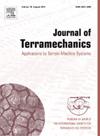用于车辆移动应用的砂和细颗粒土壤的离散元素模型的校准和验证
IF 3.7
3区 工程技术
Q3 ENGINEERING, ENVIRONMENTAL
引用次数: 0
摘要
本文提出了一种用于预测地面车辆移动的离散元(DE)计算土壤模型的标定方法。该程序依赖于使用两个小规模物理土壤试验的结果:(1)受限单轴压缩;(2)不同正应力和正预应力水平下的无侧限抗剪强度。承压单轴压缩是一种近似的静水压缩试验,用于校准DE体密度、塑性应变和弹性应变作为静水应力的函数。无侧限抗剪强度试验用于标定DE颗粒间摩擦系数和黏附应力随土体塑性应变的函数关系。本文介绍了试验装置和试验过程。本文以粉质粘土和砂质粉土两种土壤为例,演示了DE模型的标定过程。通过将两种土的模型结果与试验结果进行对比,验证了模型的有效性:(1)约束抗剪强度试验;(2)全尺寸履带车辆拉拔试验;(3)单胎拉拔试验。在中间滑移范围内,仿真结果与验证试验(2)和(3)的实验结果平均吻合在±10%以内。本文章由计算机程序翻译,如有差异,请以英文原文为准。
Calibration and validation of a discrete element model for sand and fine grain soil for use in vehicle mobility applications
In this paper, a procedure for calibrating a discrete element (DE) computational soil model for use in prediction of ground vehicle mobility is presented. The procedure relies on using the results of two small-scale physical soil experiments: (1) confined uniaxial compression; and (2) unconfined shear strength under different levels of normal stress and normal prestress. The confined uniaxial compression is an approximate hydrostatic compression test that is used to calibrate the DE bulk density, plastic strain, and elastic strain as a function of hydrostatic stress. The unconfined shear strength test is used to calibrate the DE inter-particle friction coefficient and adhesion stress as a function of the soil plastic strain. The test devices and experimental test procedures are presented in the paper. The DE model calibration procedure is demonstrated in the paper using two types of soils: silt–clay and sand-silt. The model is then validated by comparing its results for those two types of soil to experiment results for the following 3 tests: (1) confined shear strength test; (2) full-scale tracked vehicle drawbar-pull test; and (3) single tire drawbar-pull test. Within the middle of the slip range, the simulation results agree within ± 10 % on average with the experimental results for validation tests (2) and (3).
求助全文
通过发布文献求助,成功后即可免费获取论文全文。
去求助
来源期刊

Journal of Terramechanics
工程技术-工程:环境
CiteScore
5.90
自引率
8.30%
发文量
33
审稿时长
15.3 weeks
期刊介绍:
The Journal of Terramechanics is primarily devoted to scientific articles concerned with research, design, and equipment utilization in the field of terramechanics.
The Journal of Terramechanics is the leading international journal serving the multidisciplinary global off-road vehicle and soil working machinery industries, and related user community, governmental agencies and universities.
The Journal of Terramechanics provides a forum for those involved in research, development, design, innovation, testing, application and utilization of off-road vehicles and soil working machinery, and their sub-systems and components. The Journal presents a cross-section of technical papers, reviews, comments and discussions, and serves as a medium for recording recent progress in the field.
 求助内容:
求助内容: 应助结果提醒方式:
应助结果提醒方式:


